Forwarder2020 project focuses on efficiency and sustainability.
Forests are essential. They’re a major source of building materials and biomass for renewable energy, supply the air we breathe, prevent soil erosion and protect watersheds, promote biodiversity and offer countless recreational opportunities. And they play a critical role in CO2 capture and climate-change mitigation.
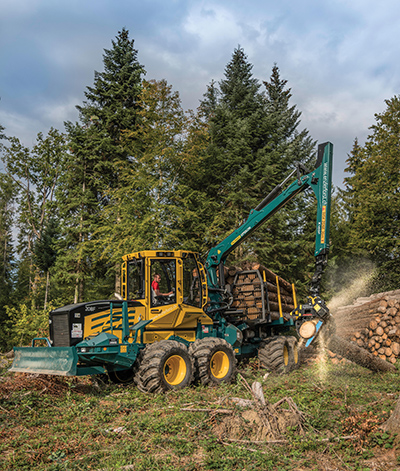
For all these reasons, there is a growing realization that forest managers must balance the commercial need to produce more wood with society’s demands for greater protection of the environment. That is the impetus behind the Forwarder2020 project. The €3 million undertaking, funded in large part by the European Union’s Horizon 2020 research and innovation program, began in late 2016 and ends this month.
Fourteen European industry and university partners, coordinated by Hohenloher Spezial-Maschinenbau GmbH (HSM), based in Neu-Kupfer, Germany, developed five innovative technology modules and tested two prototype forwarders that aim to improve the sustainability of wood production and promote “smart” logging through better management of forestry operations.
Project goals
Forwarders are articulated vehicles that carry felled timbers from the woods to a roadside landing for subsequent loading onto log trucks. They typically operate in tandem with a harvester. The machines are built to operate on uneven ground, severe slopes, wetlands and in tight quarters with narrow tree spacing.
“Forwarders are of particular interest because these forestry machines have large wheel loads that could damage unpaved forest roads, and they often must travel sizeable distances between loading in the woods and unloading at the road side,” said Felix zu Hohenlohe, Forwarder2020 project director and CEO at HSM. “Reducing fuel consumption and lowering the impact of a machine on the soil are of prime importance not only for the sustainability of logging, but also on the economic potential of forestry companies,” said zu Hohenlohe.
Thus, the Forwarder2020 project set the following objectives:
- Reduce ground pressure under the wheels to avoid deep ruts and soil compression and minimize damage to forest soils.
- Improve fuel economy to decrease emissions and limit work interruptions for refueling.
- Offer higher travel speeds while improving driver comfort, health and safety.
- Improve timber harvesting on wetlands.
- Increase transparency and documentation of timber production through better tracking and analysis of forwarding operations.
- Decrease wood-extraction costs.
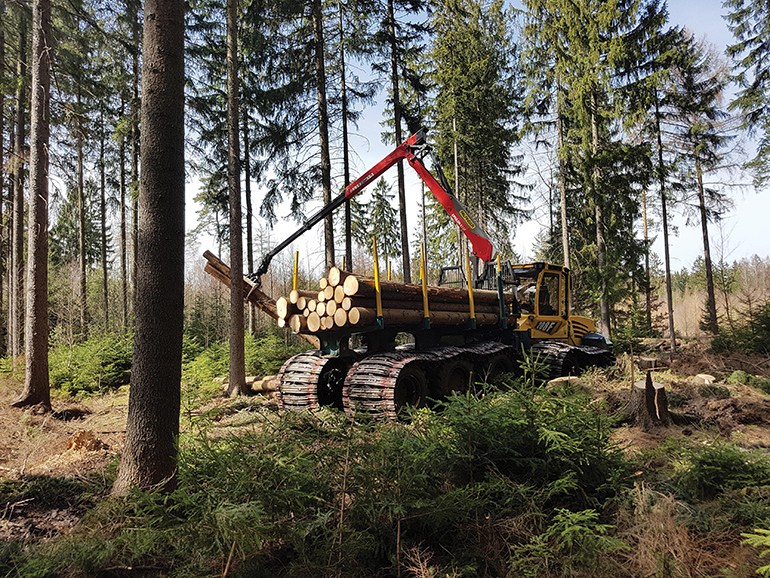
Image courtesy P. Dietsch, Bern University of Applied Sciences
The five technology modules — a hybrid hydraulic system, hydrostatic-mechanical transmission, hydropneumatic suspension, triple-bogie axle and advanced control system — addressed these requirements. They were integrated into prototypes using an HSM 208 F as the base platform and were tested in forests in Germany, Scotland, Lithuania and Romania.
Specific goals were to reduce fuel consumption by 30% and lessen impact on the soil (rut depth and dynamic wheel load) by 30%, said zu Hohenlohe. Indirectly, it could lead to sites that require fewer and less-intrusive forest roads.
Additional benefits include more-precise control when driving on rough terrain with less operator fatigue, and more precise planning and documentation of forwarder activities. Altogether, the innovations should reduce costs, occupational injuries and the environmental impact on harvesting operations. Finally, consortium members expect to market a unique and modular system of competitive high-end solutions which will let customers pick-and-choose how to tailor equipment to suit application demands.
Hybrid hydraulic system
One key feature of the Forwarder2020 prototype is a hybrid hydraulic crane system. It is designed to recover and reuse potential energy, reduce fuel consumption versus conventional load-sensing systems, permit faster handling, and lower engine speed and emissions.
That’s significant because a forwarder spends 80 to 85% of total operating time loading and unloading logs, according to Prof. Marcus Geimer and researcher Chris Geiger of the Karlsruhe Institute of Technology (KIT), a partner in the Forwarder2020 consortium. Thus, the vehicle is driving only 15 to 20% of the time.
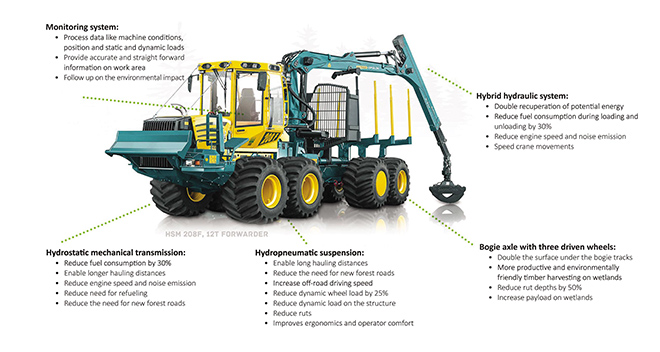
On conventional forest-harvesting cranes when the boom lowers, hydraulic flow meters through valves to decelerate the load, which generates heat and wastes energy. There are no forwarders currently on the market with built-in energy recovery systems, said the KIT officials, but there are significant opportunities where potential energy can be reused.
The KIT team designed a novel hydraulic system for energy recuperation and regeneration in the Forwarder2020 crane. A Palfinger Epsilon S11F crane, consisting of a pillar, main arm (inner boom) and articulating arm (outer boom), as well as related cylinders and grapple, was used on the prototype — although the hydraulic control system is suitable for similar cranes from other suppliers.
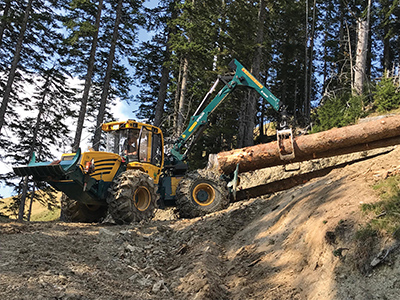
Image courtesy Hohenloher Spezial-Maschinenbau GmbH
The crane includes two hydraulic circuits that govern movement of the main and articulating arms. The main-arm circuit also includes an accumulator. With suitable controls, energy released when the arm lowers is stored temporarily and subsequently reused for lifting. That reduces demand from the main pump and conserves energy.
Each circuit also includes a hydraulic transformer, consisting of two fixed-displacement hydraulic motors whose shaft ends are mechanically connected via a coupling. Bosch Rexroth supplied the transformers and provided engineering support.
The transformers are important because there are frequent situations where the main arm and articulating arm act simultaneously, offering the potential to transfer energy between the two and make the motion significantly more efficient, said the KIT researchers.
The hydraulic transformers convert usable power by adjusting the pressure difference and volume flow for the different cylinders. For example, consider motion when the grapple extends horizontally: the inner boom lowers while the outer boom lifts at the same time. In this case, oil flows from the inner-boom cylinder to the hydraulic transformer which actuates one motor and sends flow toward the outer-boom cylinder. Simultaneously, power from one side of the transformer transfers via the mechanical connection to the other side. The second hydraulic motor/pump supplies additional flow to the outer boom cylinder to supplement pump flow, but at a significantly lower oil pressure. This results in energy regeneration, as the main pump has to do less work, said the researchers.
All in all, up to 30% energy savings in crane movement are targeted, said the KIT officials. Applications that demand frequent movements, such as in narrow thinning, will show the greatest improvement. This makes selective harvesting more competitive than clear-cutting and supports sustainable wood production from forests that can also be used for recreation. Energy savings make the process more economical and environmentally friendly.
Hydrostatic-mechanical transmission
Another significant component of Forwarder2020 is a hydrostatic mechanical transmission, which can reduce fuel consumption by as much as 30% over traditional designs. The R2 Hydromechanical Variable Transmission (HVT) is made by Dana Rexroth Transmission Systems (DRTS), based in Arco, Italy, a joint venture of Dana Corp. and Bosch Rexroth AG.
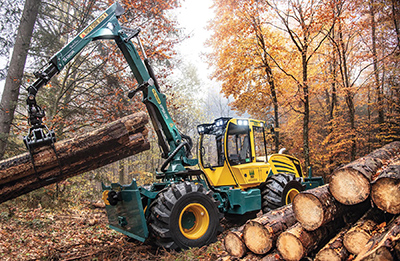
A hydrostatic-mechanical power-split transmission reportedly combines the best properties of a mechanical transmission with those of a hydrostatic travel drive, and is technologically advanced in that it provides an infinitely variable, or stepless, speed output. The HTV R2 transmission has a power rating of 130 to 200 kW (174 to 268 hp), and an enhanced version supports engine ratings to 235 kW.
The advantage is that this transmission does not have a conventional torque converter, but instead uses a hydrostatic transmission. By coupling the hydrostatic control unit and the mechanical transmission, the DRTS unit achieves an average transmission efficiency of over 85% in all drive ranges — far higher than the industry norm.
The unit reduces fuel consumption by decreasing engine speeds throughout the duty cycle and also at idle, when speeds can drop to as low as 600 rpm. The wide conversion range of the transmission and synchronous switching allow for decoupling of engine speed from travel speed. Depending on driving resistance and power demands, manufacturers can optimize the diesel engine and transmission to the best operating point. This improves efficiency and reduces noise emissions. Additional savings are possible through engine downsizing without compromising performance.
The R2 also improves acceleration while maintaining tractive effort across the entire speed range. At low travel speeds, drivers can easily control and position the vehicle with high accuracy. The purely hydrostatic first driving range offers practically wear-free, continuous and dynamic reversing without the need to shift gears. Hydrostatic braking reduces maintenance costs.
At higher travel speeds in the second and third driving range, the vehicle relies on high efficiency hydrostatic-mechanical power split technology. Shifting between driving ranges is carried out without interrupting tractive force because the transmission’s multi-disk clutches shift synchronously.
DRTS also developed the software and control strategy for the Forwarder2020 transmission. The R2 has shown proven performance in agricultural tractors. But the setup of the transmission controller and vehicle controller in forestry operations are quite different due to the need to drive fast and safely downhill with a load.
In addition to lower fuel consumption, the module economically enables longer hauling distances and reduces the number of forest roads needed. This supports more-sustainable wood production.
Lighter footprint
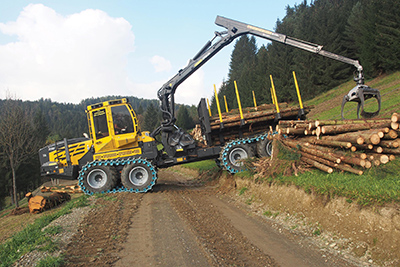
Image courtesy Hohenloher Spezial-Maschinenbau GmbH
Redesigned axles and suspension systems play an important role in lessening the environmental footprint of the forwarders. A new hydro-pneumatic suspension lowers the dynamic wheel loads by 25%, which means less rutting. And it permits driving off-road at higher speeds while reducing loads and vibrations on the structure, which improves ergonomics and operator comfort. That’s important because stricter limits for maximum exposure to vibration are expected in Europe and elsewhere.
HYDAC Systems developed and manufactured the special hydro-pneumatic suspension system. As the consortium leader in suspension’s design, HYDAC defined the hydraulic components like dampening and level-control manifolds as well as accumulators, and handled simulation and testing.
HSM developed a rear triple-bogie axle to avoid extreme ruts while extracting timber, particularly from wetlands. With three drive wheels, each side can be completely independent of the other. It doubles the surface under the bogie tracks and reduces ground pressure by approximately 50%.
This is an innovation for the forwarder market, according to HSM. It enables cost-effective, productive and environmentally friendly timber harvesting on wetlands, where standard forwarders can bog down, be unproductive, and create extremely deep ruts.
The new axle and suspension enable lighter chassis structural components at the same payload and driving speed, to either decrease dynamic wheel loads further or increase payload and thus reduce the number of passages. The forwarder design also permits a normal tandem axle.
Smart harvesting
The final and essential technology module of Forwarder2020 encompasses the hardware and software necessary to collect data during work processes and turn it into actionable information. Building blocks include sensors, HMI and a web platform to help users analyze machine data.
A monitoring system will track a number of parameters, including machine conditions, speed and location, static and dynamic loads, and even information on ground conditions. The ability to precisely monitor, control, record and document vehicle movements and loads carried during the forwarding process could ultimately lead to better decision making in forest operational planning and more-efficient and higher-quality harvest operations.
Drivers get easy-to-understand information such as warnings of soft areas to avoid. Machine owners gain details that show output and efficiency of the machine under different working conditions to help increase productivity, reduce operating costs and schedule maintenance.
Operations managers will be able to send instructions to the forwarder and document the location, quantity and weight of the wood harvested. Forest owners can access GPS data and monitor processes in real time. Even conservation organizations might be able to monitor harvesting to ensure that the environmental impact is as low as possible.
“The strategy is to implement Industry 4.0 concepts in forestry,” explained Prof. Martin Ziesak of the Bern University of Applied Sciences (BFH), a Forwarder2020 consortium member. “Our ambition is to advance the forestry and wood industries and harness the opportunities of the fourth industrial revolution in terms of harvesting output per hour, but also the ability to better monitor and actively control the new forwarder to increase the cost efficiency. A lower environmental impact and the possibility to work on less-stable soils will expand the application possibilities as well as the general acceptance for forwarders,” he said.
“And the concept of the ‘smart’ forwarder offers two other advantages. It will enable smooth integration into the logistics chain, so the entire harvesting process becomes more transparent. And the new forwarder could develop into a crafty actor that ‘knows’ what to do and can itself make decisions ‘on-the-fly’ as needed.
“In the near future automation will make it much easier for operators to work with forest machines. This will probably happen much quicker than we might think,” said Ziesak. For example, booms are tending to get longer, which makes it more difficult to properly position the harvester head. Automation will enable quicker and more precise movements, improving productivity, while softer motions put less stress on the boom and chassis frame. This trend to make machines easier to operate should also help attract qualified operators to the industry, he said.
“Full automation is already thinkable, but I do not yet see it just around the corner,” Ziesak continued. He next imagines smart master-slave systems, where the master (for example, the harvester) still has a human operator while the slave (the forwarder) works more or less automatically, but still has a loose supervision by the operator. Such pre-prototype configurations are already in the works, he said.
Forwarder2020
www.forwarder2020-project.eu

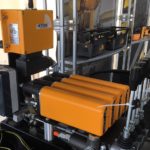
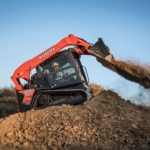
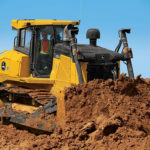
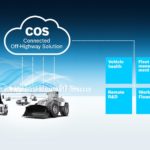

“For all these reasons, there is a growing realization that forest managers must balance the commercial need to produce more wood with society’s demands for greater protection of the environment.”
One MAJOR area for environmental protection being left out here: The use of enviro-friendly lubricants!
Forestry equipment is prone to accidental release of lubricants, and releasing conventional lubricants into prestine streams and water sheds is NOT acceptable.